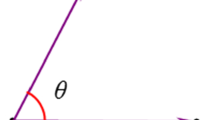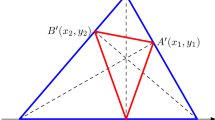Abstract
The Gröbner basis method is a powerful tool in automated geometry theorem proving. Normally, one works in the ring of coordinates of the points in a particular configuration. Tim Havel has suggested using instead the ring of interpoint squared distances because it is the invariant subring under the group of Euclidean isometries. One difficulty with this approach is that it is not always clear how to express some invariants in terms of squared distances. To that end, we present a new straightening algorithm for Euclidean invariants. We will also prove the first and second fundamental theorems of vector invariants for the group of Euclidean isometries (that the invariant subring is a finitely generated algebra over the reals, and that it can be expressed as a polynomial ring modulo finitely generated ideal, respectively. Another difficulty is that the ring of interpoint squared distances must be represented as the quotient of a polynomial ring by an ideal. Unfortunately, no canonical Gröbner basis for this ideal is known. We will present a candidate for such a basis and prove that it is a basis in some cases.
Similar content being viewed by others
References
D. Anick and G.-C. Rota, Higher-order syzygies for the bracket algebra and for the ring of coordinates of the Grassmannian,Proc. National Academy of Sciences 88 (1991).
L.M. Blumenthal,Theory and Applications of Distance Geometry, 2nd Ed. (Chelsea, Bronx, New York, 1970).
A. Conca, Gröbner bases of ideals of minors of a symmetric matrix, J. Algebra, to appear.
G.M. Crippen and T.F. Havel,Distance Geometry and Molecular Conformation (Wiley, New York, 1988).
J. Désarménien, J.P.S. Kung and G.-C. Rota, Invariant theory, Young bitableaux, and combinatorics, Adv. Math. 27(1978)63–92.
T.F. Havel, Some examples of the use of distances as coordinates in Euclidean geometry, J. Symb. Comp. 11(1991)579–593.
D.R. Richman, The fundamental theorems of vector invariants, Adv. Math. 73(1989)43–78.
L. Robbiano and M. Sweedler, Subalgebra bases, in:Commutative Algebra, eds. W. Bruns and A. Simis, Lecture Notes in Mathematics 1430 (Springer, 1988) pp. 61–87.
B. Sturmfels and N. White, Gröbner bases and invariant theory, Adv. Math. 76(1989)245–259.
B. Sturmfels and N. White, Stanley decompositions of the bracket ring, Math. Scand. 67(1990)183–189.
B. Sturmfels and W. Whiteley, On the synthetic factorization of projectively invariant polynomials, J. Symb. Comp. 11(1991)439–453.
N. White, Multilinear Cayley factorization, J. Symb. Comp. 11(1991)421–438.
Author information
Authors and Affiliations
Additional information
This work was supported by the U.S. Army Research Office through the ACSyAm branch of the Mathematical Sciences Institute of Cornell University, Contract DA AL03-91-C-0027.
Rights and permissions
About this article
Cite this article
Dalbec, J.P. Straightening Euclidean invariants. Ann Math Artif Intell 13, 97–108 (1995). https://doi.org/10.1007/BF01531325
Issue Date:
DOI: https://doi.org/10.1007/BF01531325




